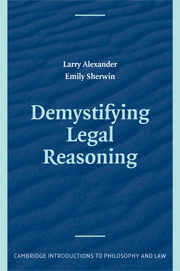Book contents
- Frontmatter
- Contents
- Introduction
- PART ONE Law and Its Function
- PART TWO Common-Law Reasoning: Deciding Cases When Prior Judicial Decisions Determine the Law
- PART THREE Reasoning from Canonical Legal Texts
- V Interpreting Statutes and Other Posited Rules
- VI Infelicities of the Intended Meaning of Canonical Texts and Norms Constraining Interpretation
- VII Nonintentionalist Interpretation
- VIII Is Constitutional Interpretation Different? Why It Isn't and Is
- Epilogue: All or Nothing
- Selected Bibliography
- Index
- References
VII - Nonintentionalist Interpretation
Published online by Cambridge University Press: 05 June 2012
- Frontmatter
- Contents
- Introduction
- PART ONE Law and Its Function
- PART TWO Common-Law Reasoning: Deciding Cases When Prior Judicial Decisions Determine the Law
- PART THREE Reasoning from Canonical Legal Texts
- V Interpreting Statutes and Other Posited Rules
- VI Infelicities of the Intended Meaning of Canonical Texts and Norms Constraining Interpretation
- VII Nonintentionalist Interpretation
- VIII Is Constitutional Interpretation Different? Why It Isn't and Is
- Epilogue: All or Nothing
- Selected Bibliography
- Index
- References
Summary
We have argued to this point that the interpretation of canonical legal texts, whether those texts are authored by individual lawmakers or by multimember ones, is at bottom no different from interpreting demands or requests in other domains of life. Requests from Mom or the kids, memos from the boss, and indeed all communications that we take to be normative boil down to what the language in its context reveals about what the speaker intended for us to do. In other words, our question is always, What meaning did the speaker or speakers intend? And, we argued, given the role of legal authorities to settle what ought to be done and to do so with expertise and, in the case of legislatures, democratic warrant, the interpretation of legal rules should also be viewed as the search for the speaker's intended meaning.
If legal reasoning in the domain of interpreting canonical legal texts is to be “special” – a craft that only legal training and practice can provide – then the intentionalist position we endorse must be rejected. We are all “trained” to practice that, as all of us engage in it all the time. And, indeed, there are challengers to intentionalism in the legal literature. In this chapter we take up the two principal challengers: textualism and dynamic interpretation.
Textualism
Textualism is actually a family of theories of legal interpretation.
- Type
- Chapter
- Information
- Demystifying Legal Reasoning , pp. 191 - 219Publisher: Cambridge University PressPrint publication year: 2008

